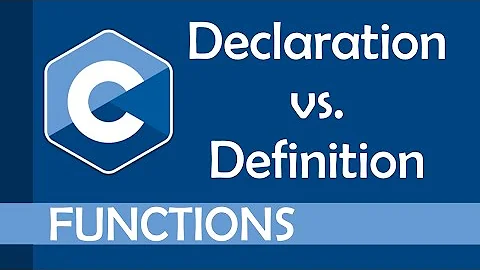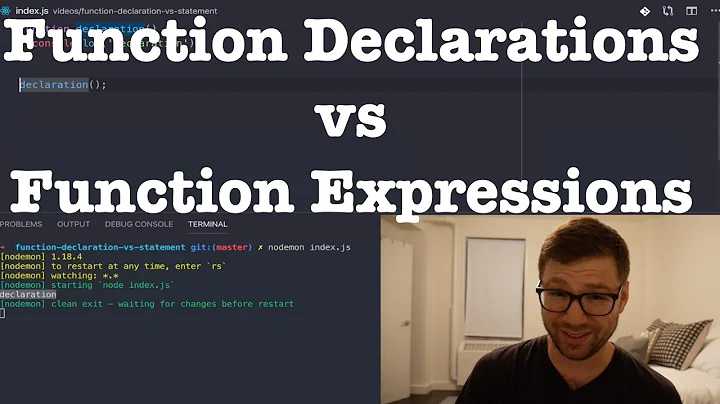Meaning of = delete after function declaration
Solution 1
Deleting a function is a C++11 feature:
The common idiom of "prohibiting copying" can now be expressed directly:
class X { // ... X& operator=(const X&) = delete; // Disallow copying X(const X&) = delete; };[...]
The "delete" mechanism can be used for any function. For example, we can eliminate an undesired conversion like this:
struct Z { // ... Z(long long); // can initialize with an long long Z(long) = delete; // but not anything less };
Solution 2
-
= 0means that a function is pure virtual and you cannot instantiate an object from this class. You need to derive from it and implement this method -
= deletemeans that the compiler will not generate those constructors for you. AFAIK this is only allowed on copy constructor and assignment operator. But I am not too good at the upcoming standard.
Solution 3
This excerpt from The C++ Programming Language [4th Edition] - Bjarne Stroustrup book talks about the real purpose behind using =delete:
3.3.4 Suppressing Operations
Using the default copy or move for a class in a hierarchy is typically a disaster: given only a pointer to a base, we simply don’t know what members the derived class has, so we can’t know how to copy them. So, the best thing to do is usually to delete the default copy and move operations, that is, to eliminate the default definitions of those two operations:
class Shape { public: Shape(const Shape&) =delete; // no copy operations Shape& operator=(const Shape&) =delete; Shape(Shape&&) =delete; // no move operations Shape& operator=(Shape&&) =delete; ˜Shape(); // ... };Now an attempt to copy a Shape will be caught by the compiler.
The
=deletemechanism is general, that is, it can be used to suppress any operation
Solution 4
Are there any other "modifiers" (other than
= 0and= delete)?
Since it appears no one else answered this question, I should mention that there is also =default.
Solution 5
The coding standards I've worked with have had the following for most of class declarations.
// coding standard: disallow when not used
T(void) = delete; // default ctor (1)
~T(void) = delete; // default dtor (2)
T(const T&) = delete; // copy ctor (3)
T(const T&&) = delete; // move ctor (4)
T& operator= (const T&) = delete; // copy assignment (5)
T& operator= (const T&&) = delete; // move assignment (6)
If you use any of these 6, you simply comment out the corresponding line.
Example: class FizzBus require only dtor, and thus do not use the other 5.
// coding standard: disallow when not used
FizzBuzz(void) = delete; // default ctor (1)
// ~FizzBuzz(void); // dtor (2)
FizzBuzz(const FizzBuzz&) = delete; // copy ctor (3)
FizzBuzz& operator= (const FizzBuzz&) = delete; // copy assig (4)
FizzBuzz(const FizzBuzz&&) = delete; // move ctor (5)
FizzBuzz& operator= (const FizzBuzz&&) = delete; // move assign (6)
We comment out only 1 here, and install the implementation of it else where (probably where the coding standard suggests). The other 5 (of 6) are disallowed with delete.
You can also use '= delete' to disallow implicit promotions of different sized values ... example
// disallow implicit promotions
template <class T> operator T(void) = delete;
template <class T> Vuint64& operator= (const T) = delete;
template <class T> Vuint64& operator|= (const T) = delete;
template <class T> Vuint64& operator&= (const T) = delete;
Related videos on Youtube
Pat O'Keefe
Updated on September 12, 2020Comments
-
Pat O'Keefe over 3 years
class my_class { ... my_class(my_class const &) = delete; ... };What does
= deletemean in that context?Are there any other "modifiers" (other than
= 0and= delete)?-
 Blindy about 13 yearsI stand corrected, I had missed this C++0x feature. I was thinking it was a
Blindy about 13 yearsI stand corrected, I had missed this C++0x feature. I was thinking it was a#definea la Qt that evaluated to a 0 and then declared a hidden function or something. -
Stewart over 5 yearsI've a recollection of a 'disable' keyword which means the same or something similar. Am I imagining it? Or is there a subtle difference between them?
-
-
LiKao about 13 yearsThere are some other uses of the
=deletesyntax. For example you can use it to explicitly disallow some kind of implicit conversions that might take place with the call. For this you just delete the overloaded functions. Have a look a the Wikipedia page on C++0x for more info. -
UncleBens about 13 yearsYou can delete any function. E.g
void foo(int); template <class T> void foo(T) = delete;stops all implicit conversions. Only arguments ofinttype are accepted, all others will try to instantiate a "deleted" function. -
mkaes about 13 yearsI will do that as soon as I find some. Guess it it time to catch up with c++0X
-
LiKao about 13 yearsYeah, C++0x rocks. I can't wait for GCC 4.5+ to be more common, so I can start using lambdas.
-
MicroVirus over 7 yearsThe description for
= deleteis not entirely correct.= deletecan be used for any function, in which case it is explicitly marked as deleted and any use results in a compiler error. For special member functions, this also means in particular that they then aren't generated for you by the compiler, but that is only a result of being deleted, and not what= deletetruly is. -
Reb.Cabin over 7 yearsIsn't the traditional method to "prohibit copying" just to make the copy-ctor and operator= "private?" This goes a bit further and instructs the compiler to not even generate the functions. If they're both private and =delete, is copying doubly-prohibited?
-
 Toby Speight almost 7 years@Reb,
Toby Speight almost 7 years@Reb,=deletemakes the method inaccessible even from contexts that can seeprivatemethods (i.e. within the class and its friends). This removes any uncertainty when you're reading the code. @Prasoon, that second example is still only deleting constructors - it would be nice to see a deletedoperator long ()for example. -
 Leushenko about 5 years@Reb.Cabin Using
Leushenko about 5 years@Reb.Cabin Using= deleteis better than usingprivateor other similar mechanisms because usually you want the forbidden function to be visibly declared and considered for overload resolution etc., so that it can fail as early as possible and provide the clearest error to the user. Any solution which involves "hiding" the declaration reduces this effect. -
Dohn Joe almost 5 yearsIs there a special reason to make the copy constructor public and apply the delete keyword. Why not leave the constructor private and apply the keyword?
-
 KeyC0de over 3 yearsCreating an object of a class with a deleted constructor is illegal.
KeyC0de over 3 yearsCreating an object of a class with a deleted constructor is illegal. -
2785528 over 3 years@Nikos - No -- You simply need to provide a constructor. The example of Adding " T() = delete; " stops the compiler from adding a (do minimal) default ctor, which is occasionally useful, but still allows you to add a (presumably-does-something-useful) ctor.
-
The Philomath over 3 yearsNot always. You can't delete a base class virtual function in derived.
-
A Fog almost 2 years= delete also works with non-member functions. This is useful for preventing implicit type conversions.






